![]()
![]()
![]()
Use LEFT and RIGHT arrow keys to navigate between flashcards;
Use UP and DOWN arrow keys to flip the card;
H to show hint;
A reads text to speech;
150 Cards in this Set
- Front
- Back
|
Station 1 – Class: Aves1.What three adaptations do birds have for flight? 2.What do all species of birds have? 3.What dinosaurs did birds emerge within? When did they show up?4.Where are birds found? |
1. Three adaptations birds have for flight: feathers, four-chambered heart, and lightweight but strong skeleton 2. All species of birds have: wings 3. Birds emerged within the Theropod dinosaur/ They showed up: Jurassic period around 150mya 4. Birds are found: most terrestrial habitats on all 7 continents |
|

Station 2 – Evolutionary History - Archaeopteryx1.What characteristics are seen in Archaeopteryx that are bird-like?2.What characteristics are seen in Archaeopteryx that are reptile-like? |
1. Archaeopteryx bird-like characteristics: wings, feather, lightly built body with hollow bones, furcula (wishbone), reduced fingers. 2. Archaeopteryx reptile like characteristics: teeth, three claws on each wing, flat sternum, belly ribs, long bony tail. |
|
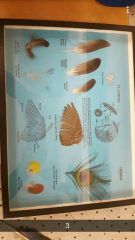
Station 3 – General Characteristics - Feathers1.What are feathers made of?Be able to recognize the six types of feathers and know their functions. Also be able to recognize the feathers in the display. |
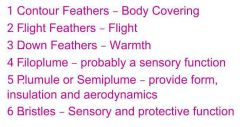
1. feathers are made of: keratin |
|
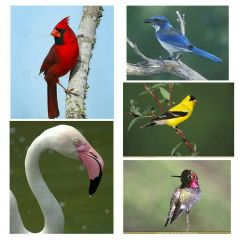
Station 4 – General Characteristics - Color1.What causes the different colors we see in bird’s today?2.What are the different types of plumage mentioned and what is their function?3.Know what produces the following colors in the following birds.Red in Northern Cardinals:Pink in Flamingo’s: Blue in Western Scrub-JaysYellow in the American GoldfinchIridescent colors in the Anna’s Hummingbird |
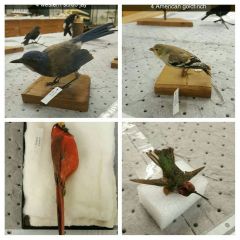
1. pigments cause the different colors we see in bird's today 2. Different type of plumage and their function: Bright plumage (attraction in courtship mating rituals), Muted plumage ( camouflage while nesting), Seasonal change (camouflage during season changes) 3.What produces the following colors: Red in Northern Cardinals: red carotenoids Pink in Flamingo's: red and yellow carotenoids pigments Blue in Western Scrub Jays: nanostructural (constructive interference) Yellow in the American Goldfinch: The inner core of a yellow feather is devoid of pigment, so only the light yellow color of the carotenoid is visible. Iridescent colors in the Anna's Hummingbird: minute reflectors |
|

Station 5 – General Characteristics - Bones and Muscles1.What are the three regions in birds where bones are fused together and what are each of them called?2.What is the muscle in birds which lifts their wings? What is the muscle that is used to lower the wings? 3.How much of a bird’s body mass is accounted for by the flight muscles?4.Do birds have teeth? Why or why not? |
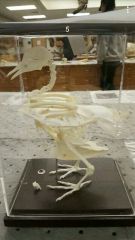
1.The three regions where bones are fused/ what are they called: Throax: furcula Pelvis: synsacrum Outerwing: carponmetacarpus 2. The muscle in birds that lifts their wings is the supracoracoideus/ The muscle that is used to lower the wings is the pectoralis. 3. 20-25% of a bird's body mass is accounted for by the flight muscles. 4. |
|
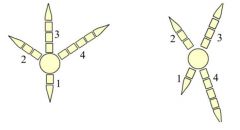
Station 6 – General Characteristics – Bipedalism and Feet1.Although most tetrapods are quadrupeds, what is the term used for birds?2.The part of a bird’s leg that looks like a “backwards” knee is actually what part?3.What is the name of the type of foot seen on the left below? 4.What is the name of the type of foot seen on the right? |
1. Bipedal is the term used for birds. 2. the ankle is the part of a bird's leg that looks like a "backwards" knee. 3. Anisodactylie 4. Zygodactylie |
|
|
Station 7 – General Characteristics – Metabolism 1.What type of metabolic rate do birds have?2.What is the normal range of body temperatures?3.What zones are birds usually larger? Why?4.What two functions does the respiratory system play?5.What respiratory structures do birds have? 6.What do air sacs permit? |
1. birds have an endothermic metablic rate 2. the normal body temperature range is 38-42 degrees C (100-108 degrees F) 3. usually larger in temperate zones to limit surface area to reduce heat loss. 4.Two functions of the respiratory system: delivers oxygen from the air to tissues and removes carbon dioxide. 5. Respiratory structures: small lungs plus 9 air sacs 6. air sacs permit unidirectional flow of air through the lungs. |
|
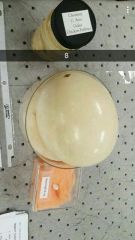
Station 8 – General Characteristics - Reproduction1.Other vertebrates lay eggs, but bird egg laying is unique among vertebrates. Why?2.What is the largest egg?3.What is the smallest egg? |
1. bird egg laying is unique because eggs have a hard covering for protection. 2. the largest egg is an Ostrich egg. 3. the smallest egg is a hummningbird's egg. |
|
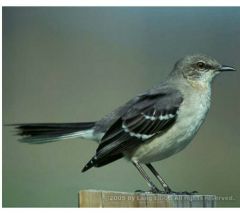
Station 9 – Reproductive Behavior – Monogamy1.What is meant by Socially Monogamous? 2.What are Extra-pair copulations? 3.How many species of birds are considered Socially Monogamous? |
1. Socially monogamous means: birds that raise young together. 2. Extra-pair copulations is "cheating" 3. 90% of species of birds are considered socially monogamous. |
|

Station 10 – Reproductive Behavior – Red-winged Blackbirds1.What is polygyny? 2.What conditions favor this condition? |
1. polygyney: when one male has multiple females 2. conditions that favor this condition: colonial groups where there is enough resources for females to feed the young along and the young are independent early in life. |
|
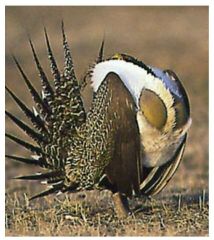
Station 11 – Reproductive Behavior – Sage Grouse1.What is Lekking? What is the name of the area used for display?2.What are the benefits of Lekking? |
1. Lekking is where males collect in a group to perform courtship displays./ The name of the area used for display: arena or booming ground. 2. the benefit of Lekking: for males-they are found in areas without resources so the arena allows them to show off their genetic qualities. Females are able to choose males quickly and the young females can learn from the more experienced females. |
|
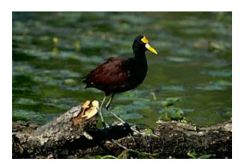
Station 12 – Reproductive Behavior – Northern Jacana1.What is polyandry?2.Using this type of reproductive behavior, what happens to the sexual roles in these birds?3.What is the evolutionary reason for polyandry? |
1. polyandry: where the female attracts more than one male. 2. the sexual roles are reversed, the females fight for territories, males, and resources. 3. the evolutionary reason for polyandry: one parent doesn't have to worry about parental care and can concentrate on offspring number. It allows the females to reproduce quicker because the females do not have to care for the young. |
|
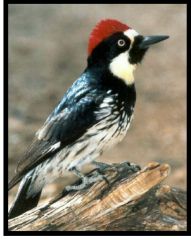
Station 13 – Reproductive Behavior – Acorn Woodpecker1.What is polygyandry?2.Why do Acorn woodpeckers primarily live in groups? 3.What is special about the way they nest? |
1. polygyandry: females will be paired with several males and males will be paired with several females. 2. Acorn woodpeckers primarily live in groups to protect their storage of acorns. 3. the way they nest is special because several females will lay their eggs in a single nest and each will compete to leave the most eggs. |
|
|
Station 14 – Reproductive Behavior – Brown-headed Cowbirds1.What is brood parasitism?2.How many species do they parasitize?3.What is the cost to the host species? |
1. brood parasitism: where females lay their eggs in another species nest. The parasitized species then raises the cowbird's young. 2. They parasitize 140 of 220 species. 3. The cost of the host species: reduced production of young and is a major threat to a few very vulnerable species. |
|
|
Station 15 – Reproductive Behavior – Phainopepla1.What is this birds typical diet?2.What is unique about this birds nesting behavior?3.How do they behave in the desert environment?4.How do they behave in the woodland area? |
1. typical diet: mistletoe berries 2. unique about birds nesting behavior: breeds twice each year, in two different habitats. 3. behavior is desert environments: territoerial, actively defending nesting and foraging sites. 4. behavior in woodland area: colonial, with as many as four nesting pairs sharing one large tree. |
|
|
Feeding Behavior-Adaptation: Ostrich |
-food is collected in the crop at the top of the throat until there is a large enough lump to slide down the neck. -omnivorous |
|
|
Feeding Behavior-Adaptation: Brown Kiwi |
-nostrils at the tip of their long, slender beak, to help them smell food when they push their beak into the soil. |
|
|
Feeding Behavior-Adaptation: Indian Yellow-nosed Albatross |
surface and/ or shallow dives |
|
|
Feeding Behavior-Adaptation: Great Blue Heron |
-stands motionless. -slowly wades around in about 15 to 25 cm of water until it drives a fish out from a hiding place. |
|
|
Feeding Behavior-Adaptation: Scarlet Ibis |
-thin bill perfect for probing in water or mud in its search for food. - sensitive feelers on the inside of their bill. - The bird's nostrils are at the base of the bill. |
|
|
Feeding Behavior-Adaptation: Roseate Spoonbill |
sweeping its long spoon- shaped bill back and forth in the ewater. Prey is detected by touch. |
|
|
Feeding Behavior-Adaptation: Caribbean Flamingo |
-in shallow water, lower their necks and tilt their heads slightly upside-down, sweeping their head from side to side. -Filter food with a spiny, piston like tongue that aids in sucking food-filled water past the lamellae inside the curved bill. |
|
|
Feeding Behavior-Adaptation: Duck |
bill are fringed to strain |
|
|
Feeding Behavior-Adaptation: Harpy Eagle |
-talons are extremely powerful and help assist with suppressing prey. -main prey items are tree-dweling mammals such as monkeys, coastis, and sloths. |
|
|
Feeding Behavior-Adaptation: Peregrine Falcon |
-strike prey with a clenched foot, stunning or killin git, then turns to catch it in mid-air. -feed almost exclusively on medium-sized birds. -speeds of 220mph. |
|
|
Feeding Behavior-Adaptation: Turkey Vulture |
-sense of smell. -feeds almost exclusively on carrion. |
|
|
Feeding Behavior-Adaptation: California Condor |
-may travel several hundred miles in search of food. -medium and large sized dead mammals. |
|
|
Feeding Behavior-Adaptation: Common snipe |
forages in soft mud, probing or picking up food by sight. |
|
|
Feeding Behavior-Adaptation: King penguin |
-eats small fish and squid. -fish constitute 80-100% of diet |
|
|
Feeding Behavior-Adaptation: Black Hornbill |
-very dextrous bill -diet consists mostly of fruit but also 20% of their diet is invertebrates and small animals. |
|
|
Feeding Behavior-Adaptation: Toco Toucan |
-long bill is useful for reaching things that otherwise would be out of reach. -eats fruit using its bill to pluck them from trees. |
|
|
Feeding Behavior-Adaptation: Scarlet Macaw |
-strong bill is adapted not only to crush its food, but also as an additional limb for climbing. |
|
|
Feeding Behavior-Adaptation: owl |
-birds of prey, must kill other animals to survive. |
|
|
Feeding Behavior-Adaptation: Pileated woodpecker |
-chisel. - most feed on insects which live under the bark. |
|
|
Feeding Behavior-Adaptation: wren |
-thin slender, pointed beaks for eating insects. |
|
|
Station 17 – Resource Partitioning 1.What is resource partitioning? 2.How does an American Avocet’s bill differ from a Black legged Stilt? |
1. resource partitioning: to reduce competition, the different type beaks allow for each species to specialize in a particular food source reducing the energy needed to fight fo food. 2. The American Avocet's bill turns upward to skim the surface of the sand and the Black-necked stilt is straight to dig into the sand. |
|
|
Station 18 – Ducks (Dabblers vs. Divers)1.What is a dabbler? What is a diver?2.How do the legs differ between these two different types of duck?3.Know the Northern Pintail and Northern Shoveler which are dabblers and the Hooded Merganser is a diving duck. |
1.A dabbler: typically skim food from the suface or feed in the shallows by tipping forward to submerge their head and neck./ A diver: ducks that propel themselves underwater. 2. Dabbler legs: smaller feet and their legs are suited farther forward./ Diver legs: large feet attached to short legs situated far back on the body. |
|
|
Station 19 – Birds of Prey - Loggerhead Shrikes1.Why are they considered a bird of prey?2.How do they kill their food?3.What is their nickname? |
1. considered a bird of prey because they are predators of insects, lizards, birds, and small mammals. 2. They kill their food by shearing food on cactus spines and barb wire fences. 3. Nickname: Butcher Bird |
|
|
Station 20 – Birds of Prey - Hawks and Falcons1.What is the common diet for a Red-tailed Hawk?2.What is the Peregrine Falcon known for? What do they eat?3.What is a Kestrel? What do they eat? What is “unique” about their flight pattern? |
1. common diet for a red-tailed hawk: 85-90% of small rodents with rabbits, snakes, and lizards. 2.Peregrine Falcon is known for speeds being clocked at 220mph in a stoop dive/ They eat birds. 3. a Kestrel in a North American falcon/ They eat insects or small mammals/ "unique" about their flight pattern: hover with rapid wing beats keeping head motionless while scanning the ground for prey. |
|
|
Station 21 – Birds of Prey - Owls1.Why are owls thought to be nocturnal?2.How far can Owl’s turn their head? Why can they do this? Why is it necessary?3.Which species of Owl is diurnal? How do the young protect themselves in the nest?4.Know the difference between the Barn Owl and the Great Horned Owl. |
1. owls are thought to be nocturnal due to competition from hawks during th day. 2. Owl's can turn their head: 240 degrees/ they can do this because of their 14 cervical vertebrae/ it is necessary because their eyes are large and fixed in sockets so they must turn head to look at things. 3. the burrowing owl is diurnal/ the young protect themselves by making a sound by clicking their beaks which resembles a rattlesnake. |
|
|
Station 22 – Avoiding Predators- Killdeer1.Where do these birds lay their eggs?2.How do the adults protect their young? |
1. Kill deer lat their eggs on open ground , often on gravel. 2. Adults use the "broken wing act" to distract predators from nest. |
|
|
Station 23 – Introduced Species 1.Why were Starling introduced to the United States? What problems are they causing?2.What is one of the more common introduced species in our area? What was their original name? |
1. Starlings were introduced to the U.S. because of the Shakespearean plays./ The problems they are causing: affecting local woodpecker populations. 2. The house sparrow is on of the most common introduced species in our area./ Their original name in the English sparrow. |
|
|
Station 24 – Communication1.How do birds communicate?2.What do songs consist of? How does a song of a cardinal differ from that of a mockingbird?3.How do birds produce these sounds? Why do mourning doves making only cooing noises?4.What is a call? How do bushtits use these?5.How do you recognize the call of a Wrentit?6.What separates the Western Meadowlark species from the Eastern Meadowlark |
1. Birds communicate with songs and calls or other noises (tapping and drumming), courtship flights and dances. 2. songs consist of specific patterns or notes repeated with few variations./ The cardinal has over a dozen calls and songs, mockingbirds are able to mimic the songs of other birds. 3. Birds produce sound from vibrations that are sent across the syrinx (voice box) of a bird./ Mourning doves have a singular pair of muscles results in only "coo" sound. 4. A call is when alerting others of danger, when feeding or migrating./ Bushtits use these when a flock of bushtits travel, they keep in touch by calling as they fly through their habitats. 5.To recognize the call of a Wrentit, their call's rhythm is like a dropped ping pong ball. 6. Western Meadowlark species: the young learn the song while still in the egg |
|
|
Station 26- Bird Migration1.What are the four groups birds can be placed in? 2.Why do birds migrate?3.What are the four “flyways” in North America? |
1. Four groups: Permanent resident, Winter resident, Summer resident, and Transients. 2. birds migrate because during northern winters there is little food and cold temperatures, making life hard. Farther south, there is more food and less cold. 3. The four "flyways" in North America: Pacific, Central, Atlantic, and Mississppi. |
|
|
Station 27 – Desert Adaptations – Roadrunners1.What is torpor? Why do roadrunners do this?2.What adaptation do Roadrunners have to help them use less energy “waking up” from torpor? |
1. Torpor: lowering metabolism overnight/ Roadrunners do this to conserve energy. 2. Adaptation roadrunners have to help use less energy "waking up" from torpor: have black skin underneath feathers. In the mornings they will pull back these feathers and allow the sun to warm their bodies and help raise their body temperature back to normal. |
|
|
Station 28 – Desert Adaptations - Cactus Wrens1.How did these birds get their name?2.Why do these birds make multiple nests? |
1. Cactus wrens got their name from making their nests in cactus. 2. Cactus wrens make multiple nests to use as rest areas to get out of the heat. |
|
|
Station 29 – Desert Adaptations – Gambel’s Quail1.What is their typical body temperature? What can they do to this temperature to reduce water loss?2.How much body weight can they lose in water? |
1. Gambel's Quail typical body temperature is 104 degrees F./ To reduce water loss they can raise it 7 to 8 degrees. 2. They can lose up to 50% of their body weight in water. |
|
|
Station 30 – Other Behaviors – Penguins and Alcids1.Where are penguins found? Where are Murrelets and Auklets found?2.What do they have in common? How are they different? |
1. Penguins are found in the south hemisphere/ Murrelets and Auklets are found in the northern hemisphere. 2. Have in common: all cold-loving, fish gulping birds, and usually breed in colonies./ Difference: penguins do not fy while Alcids can. |
|
|
Station 31 – Other Behaviors - Hummingbirds and Swallows1.What does the order these birds are in mean?2.What do hummingbirds eat?3. Be able to identify the hummingbirds at this station.4.What do swallows eat?5.What types of nest do they make?6.Be able to identify the swallows at this station |
1. order means "footless" 2. hummingbirds eat nectar. 4. swallows hunt insects in the air. 5. swallows make mud nests attached to cliffs and building structures. |
|
|
Station 32-Other Behaviors-Common Birds: American Robin 1. Location 2.Food 3.Other |
1.Location: Most of U.S. woodlands and grasslands. 2. Food: 40% invertebrates and 60% nuts and berries. 3. Other: often seen as a symbol of spring. |
|
|
Station 32-Other Behaviors-Common Birds: Brewer's Blackbird 1.location 2. Food 3. Other |
1. location: central and western U.S. open areas and grasslands. 2. Food: mostly seeds and insects. 3. Other: live in large flocks near humans. |
|
|
Station 32-Other Behaviors-Common Birds: Black Phoebe1.location2. Food3. Other |
1. location: western U.S. near water. 2. Food: flycatcher 3. Other: pump their tails up and down incessantly when perched. |
|
|
Station 32-Other Behaviors-Common Birds: California Gnatcatcher1.location2. Food3. Other |
1. location: coastal sage scrub in southern california 2. food: insects. 3. other: endagered |
|
|
Station 32-Other Behaviors-Common Birds: California Thrasher1.location2. Food3. Other |
1. location: dense brush of coastal sage scrub in southern california 2. food: insects and small invertebrates. 3.other: largest thrasher |
|
|
Station 32-Other Behaviors-Common Birds: California Towhee1.location2. Food3. Other |
1. location: coastal sage scrub in southern california 2.Food: seeds and insects. 3. Other: spends most of its time on the ground |
|
|
Station 32-Other Behaviors-Common Birds: Crow1.location2. Food3. Other |
1. location: most habitats throughout the U.S. 2. Food: omnivorous 3. Other: Bio indicator for West Niles Virus |
|
|
Station 32-Other Behaviors-Common Birds: House Finch1.location2. Food3. Other |
1. location: western U.S.- introduced in the east- variety of habitat but often near humans. 2. Food: seeds 3. other: frequent visitor to bird feeders |
|
|
Station 32-Other Behaviors-Common Birds: Northern Oriole1.location2. Food3. Other |
1. Location: western and Eastern U.S. 2. Food: insects, berries, and nectar. 3. Other: Frequent visitor to hummingbird feeders. |
|
|
Station 32-Other Behaviors-Common Birds: Plain Titmouse 1.location 2. Food 3. Other |
1. location: dry slopes of california 2. food: seeds and insects. 3. other: 40 attempts at insects every 15 minutes. |
|
|
Station 32-Other Behaviors-Common Birds: Spotted Towhee 1.location 2. Food 3. Other |
1.location: shrubby undergrowth in western U.S. 2. food: omnivore 3. other: two footed backward scratching called, "double scratching" |
|
|
Station 32-Other Behaviors-Common Birds: Western Bluebird1.location2. Food3. Other |
1. location: open woodlands of the western U.S. 2. food: insects 3.other: last year, young often help at the nest. |
|
|
Station 32-Other Behaviors-Common Birds: Western Kingbird1.location2. Food3. Other |
1.location: open areas with perches in the western U.S. 2. food: insects 3.other: spreading in the U.S. due to human activity. |
|
|
Station 32-Other Behaviors-Common Birds: Yellow-rumped Warbler1.location2. Food3. Other |
1. location: summer-open forest edges/ Fall and Winter-open woods and shrubby habitats. 2. food: insects and berries 3. other: most versatile feeder among all warblers |
|
|
Station 33- Bird Orders: Pelicaniformes |
Pelicans |
|
|
Station 33- Bird Orders: Coraciformes |
Kingfishers |
|
|
Station 33- Bird Orders: Apodiformes |
hummingbirds |
|
|
Station 33- Bird Orders: Columbiformes |
pigeons, doves |
|
|
Station 33- Bird Orders: Falconiformes |
raptors |
|
|
Station 33- Bird Orders: Anseriformes |
Ducks |
|
|
Station 33- Bird Orders: Galliformes |
Quail |
|
|
Station 33- Bird Orders: Gruiformes |
Coots |
|
|
Station 33- Bird Orders: Charadriiformes |
shorebirds |
|
|
Station 33- Bird Orders: Psittaciformes |
parrot, parkeets |
|
|
Station 33- Bird Orders: Cuculiformes |
Greater roadrunner |
|
|
Station 33- Bird Orders: Strigiformes |
Owls |
|
|
Station 33- Bird Orders: Piciformes |
woodpeckers |
|
|
Station 33- Bird Orders: Casuariiformes |
Cassowaries |
|
|
Station 33- Bird Orders: Struthioniformes |
ostriches |
|
|
Station 33- Bird Orders: Rheiformes |
Rheas |
|
|
Station 33- Bird Orders: Apterygiformes |
Kiwis |
|
|
Station 33- Bird Orders: Tinamiformes |
Tinamous |
|
|
Station 33- Bird Orders: Sphenisciformes |
penguins |
|
|
Station 33- Bird Orders: Troganiformes |
Trogons |
|
|
Station 33- Bird Orders: Gaviiformes |
Loons |
|
|
Station 33- Bird Orders: Podicipediformes |
Grebes |
|
|
Station 33- Bird Orders: Procellariiformes |
Tubenoses |
|
|
Station 33- Bird Orders: Ciconiiformes |
waders |
|
|
Station 33- Bird Orders: Caprimulgiformes |
nighthawks |
|
|
Station 33- Bird Orders: Passeriformes |
songbirds |
|
|
Station 1 – Class: Mammalia1.What are the general characteristics listed for mammals?2.When did the first mammals appear? 3.When did the modern mammalian orders appear?4.Where are they found? |
1. general characteristics: hair, three middle ear bones, mammary glands in females, and a neocortex. 2. first mammals appear in early Mesozoic era. 3. modern mammalian order appear: Paleogene and Neogene periods of the Cenozoic era. 4. found: worlwide in almost every habitat |
|
|
Station 2 – General Characteristics – Hair1.What is it composed of?2.What is a complete coat of fur called?3.What are the two main layers of hair and what are they used for?4.What are the functions of hair? |
1. hair is composed of keratin. 2. a complete coat of fur is called: Pelage 3. Two main layers of hair and used for: Ground hair (undercoat or down hair)-thermoregulation/ Guard hair-display, camouflage or protection 4. functions of hair: primary source of heat insulation and cooling, protection from U.V. radiation, sense movement of air as well as touch by physical objects, and protection. |
|
|
Station 3 – General Characteristics – Middle Ear1.What are the names of the three ossicles?2.What is the single bone in reptiles called? Where did the extra two middle ear bones come from?3.What is the function of these new bones? |
1. Three ossicle names: malleus, incus, and stapes 2. the single bone in reptiles is called: columella/ the two extra middle ear bones come from: one lower and one upper jaw bone (the articular and quadrate) lost their purpose in the jaw joint and were put to a new use in the middle ear. 3. the function of theses new bones: amplify sounds and allow for more acute hearing. |
|
|
Station 4 – General Characteristics – Jaw Joint and Teeth1.What two bones form the jaw?2.What two bones form the jaw joint?3.How long did it take for the synapsid skull to evolve?4.How have vertebrate teeth changed? What are the different types and their functions?5.What has the shift in the jaw joint allowed? |
1. The two bones that form the jaw is the dentary and squamosal. 2. The two bones that form the jaw joint is the articular and quadrate. 3. It took over 100 million years for the synapsid skull to evolve. 4. vertebrate teeth changed from modified peg-like teeth into specialized structures for certain tasks./ The different types and their function: incisors (shearing), canines (piercing), and premolarsand molars (grinding) 5. the shift in the jaw joint has allowed for more power in the bite. |
|
|
Station 5 – General Characteristics – Mammary Glands1.What type of gland is a mammary gland? What is its function?2.What type of gland is it modified from? |
1. mammary glands are a specific type of apocrine gland specialized for the manufacture of colostrum when giving birth. 2. modified from sweat or sebaceous glands. |
|
|
Station 6 – General Characteristics – Neocortex1.What does the word mean? Where is it located?2.How does the neocortex consist of? How does this area differ from rodents to larger mammals? 3.What is the name of the grooves and wrinkles? What do they allow for?4.What are the functions of this region? |
1. Neocortex means "New bark"/ loacted: part of the cerebral cortex 2. Neocortex consist of: grey matter surrounding the deeper white matter of the cerebrum./ Differ from rodents to larger mammals: rodents have smooth neocortex, larger mammals have deep grooves and wrinkles. 3. Grooves: sulci/ wrinkles: gyri/ allow for increase in surface area of the neocortex. 4. the functions of region: "higher function" |
|
|
Station 7 - Mammal Classification1.What are the three major types of mammals and their characteristics? |
1. Three major types of mammals and characterisitcs: Protheria- monotremes (egg layers) Metatheria- marsupials (pouch animals) Eutheria- placentals (nourished before birth) |
|
|
Station 8 – Subclass: Protheria1.What does the word Protheria mean? 2.What therapsid ancestor characteristics do they contain?3.When did they split from the other mammals?4.Where were they probably found? |
1. Protheria means "first beast" 2. Therapsid ancestor characteristics they contain: complex pectoral girdle, laying eggs, limbs oriented with humerus and femur held lateral to body and a cloaca. 3. the split from other mammals in the Mesozoic during the Cretaceous period. 4. probably found on landmass of Gondwana |
|
|
Station 9 – Order: Monotremata – Be Able to recognize the two animals from this station1.What does the word monotremata mean?2.What makes them different than other mammals? 3.How is milk delivery different than other mammals?4.What do they use to locate prey?5.Where are they found today?6.Monotremes are one of two groups of venomous mammals. What structure delivers the venom in male Duck-billed Platypus? What behavior do they do while hunting to take advantage of their electroreceptors? Where are they found?7.What do echidnas feed on? How do their electrosensors compare to the platypus? |
1. monotremata means: sewer 2. different from other mammals: lack teeth as adults, sutures are hard to see, rostrum is elongate, beak-like and covered by a leathery sheath, and lacrimal bones are absent. 3. milk delivery different than other mammals: milk is secreted onto the skin within the pouch and sucked or lapped up by the babies. 4. they use electroreception to locate prey. 5. found: Australia and New Guinea 6. spurs deliver the venom in male Duck-billed Platypus/ To take advatage of their electroreceptors they move their head in a side-to-side motion/ found: inhabiting small streams and rivers. 7. echidnas feed on ants and termites/ Platypus has 40,000 electroreceptors, the echidnas has only 2,000. |
|
|
Station 10 – Subclass Metatheria1.What does the word Metatheria mean? 2.What do these animals give birth to? What must they attach to?3.When did they diverge from the ancestors of placentals?4.Where are they found today? |
1. Metatheria means: "sort-of beast" 2. give birth to "larval-like" offspring. 3. diverged from ancestors of placentals in the Jurassic period. 4. found today: Australasia, some inhabit the Americas |
|
|
Station 11 – Order: Marsupialia1.What makes marsupials different from placental mammals?2.What is unique about their penis and vagina?3.When and where did they first evolve? When did they reach Australia?4.Be able to recognize the following animalsKangaroo (Skull)Koala (Picture)Virginia Opossum (Skull and Specimen)Brush-tailed Possum (Meek)5.What is unique about the Red Kangaroo?6.What do koalas eat and what does this cause them to do?7.What is the only marsupial found in this area (Southern California)? What type of tail do they have? What do they have on their back feet which are similar to those in primates?8.How many teeth do opossums have? What do they eat? 9.What do they do when confronted by a predator?10.Their immune system is robust. Why are they not carriers of rabies?11.How are the Brush-tailed Possum different from other opossums? Where are they from and where are they found now? |
1. what makes marsupials different from placentals mammals: young are carried in a pouch. 2. The penis and vagina is bifurcated. 3. evloved in North America approximately 80mya/ Reached Australia in the Oligocene. 5. unique about the red kangaroo: largest of all kangaroos, the largest mammal native to Australia, and the largest extant marsupial. 6. Koalas eat eucalypt diet provides low nutrition and energy, koalas are laregely sedentary and sleep for up to 20 hours a day. 7. the only marsupial found in this area (sputhern California): The Virgina Oppossum/ Type of tail: hairless, prehensile tails./ Have opposable, clawless thumbs on their back feet which are similar to those in primates. 8. opossumes have 50 teeth/ Eat: omnivores 9. when confronted by predators they: feigning death 10. They are not carriers of rabies because their body temperature is too low to carry rabies. 11. Brush-tailed Possum are different from other opossums because they have a almost fully haired tail./ From South America and introduced to New Zealand |
|
|
Station 12 – Subclass: Eutheria1.What does the word Eutheria mean? 2.How do they differ from non-eutherian mammals? What does this allow them to do?3.When did they evolve? 4.Where are they found? |
1.Eutheria means: "true beast" 2.Differ from non-eutherian mammals: lack the epipubic bones, which are present in all other fossil and living mammals./ Allows them to be faster on the run than their relatives. 3. evolved: 160mya 4. found: worldwide |
|
|
Station 13 – Order: Tubulidentata 1. What do Aardvarks eat? What is the term for this type of feeder?2. How are their teeth different than other mammals? |
1. Aardvarks eat: ants and termites/ Term for this type of feeder: Formicivore 2. Teeth are different than other mammals: no enamel coating and are worn away and regrow continuously. |
|
|
Station 14 – Order: Proboscidea1.How do they use their trunk?2.How much does the skull comprise of an elephant’s body weight? What other changes have occurred to their skull to accommodate their large size?3.What adaptations are seen in an elephant’s foot?4.What is the difference between African and Asian Elephants? |
1. Use their trunk by grabbing food and water. Use their trunk like humans use their hands, with an upper and lower lip to grab food. 2. 12-25% of the skull comprises of an elephant's body weight/ Other changes that have occurred to their skull to accommodate their large size: a network of air-cells and cavities to reduce its weight. 3. Adaptations seen in an elephant's foot: the toes are embedded in a soft cushion of elastic fibers around a fatty matrix. 4. Difference between African and Asian Elephants: Ears: African (Huge ears shaped like Africa)/ Asian (smaller) Tusks: African (tusks on maes and females)/ Asian (tusks on males). Nails on back feet: African (three nails on hind feet)/ Asian (5 toes but only 4 nails on hind feet) |
|
|
Station 15 – Order: Hyracoidea1.What does the word hyrax mean?2.What are their closest living relatives?3.How do they slice off leaves and grass? What do they have that allows them to digest plant material? |
1. hyrax means: shrewhouse 2. closest living relatives: elephants 3. slice off leaves and grass: using molar teeth/ Have multi-chambered stomachs that allow symbiotic bacteria to break down tough plant material. |
|
|
Station 16 – Order: Sirenia1.What is the common name of these animals? What do they eat?2.What modification do they have for their aquatic way of life?3.What are their closest relatives? |
1. common name: sea cows/ eat: herbivorous 2. modification for their aquatic way of life: the forelimbs have modified into arms used for steering, the tail has modifiedinto a paddle used for propulsion, and the hindlimbs are but two remnant bones floating deep in the muscle. 3. closest relatives: elephants |
|
|
Station 17 – Order: Xenarthra1.What does Xenarthra mean? Why do these animals have this name?2.What makes them different than all eutherians and allows the males to have internal testicles?3.Be able to recognize the examples: Armadillos (specimen and skull), Anteaters (picture and skull), and Sloths (picture).4.What is the Armadillo’s outer shell made of? Why is the Armadillo quickly spreading in the U.S.?5.How many times does the anteaters tongue move in and out of their mouth when feeding? Because their prey (insects are swallowed, how do they crush their prey? They don’t make stomach acid. What do they use instead?6.What are sloths classified as? What do they use for camouflage? When are they most vulnerable to predation? |
1. Xenarthra means: "strange joints"/ Animals have this name because their vertebral joints have extra articulations. 2. Different than all eutherians and allows the males to have internal testicles: the lowest metabolic rates among the eutherians. 4. Armadillo's outer shell made of: ossified dermal scutes covered by nonoverlapping, keratinized epidermal scales, which are connected by flexible bands of skin./ Armadillos are quickly spreading in the U.S. because the species has few natural predators within the U.S. 5. Anteaters move their tongue in and out 160 times per minute when feeding./ Because their prey, insects are crushed against the palate./ Instead of stomach acid, the formic acid of its prey is used for digestion. 6. Sloths are classified as folivores/ They use two species of symbiotic cyanobacteria for camouflage./ They are the most vulnerable to predation when they are on the ground to urinate and defecate about once a week. |
|
|
Station 18 – Order: Rodentia1.What % of mammal species are rodents?2.What are they characterized by? 3.Rodents lack canines so they have a space between the incisors and the premolars. What is this space called?4.When did they first appear?5.Be able to recognize the following animals; Naked Mole Rats (picture), Beaver (skull, specimens in both the museum and Meek), Ground squirrel (specimen), Gray Squirrel (specimen), Kangaroo Rat (specimen), Capybara (Skull), Gopher (skull and specimen), Deer Mouse (specimen), Norway Rat (specimen), Antelope Ground Squirrel (specimen), Chipmunk (specimen) |
1. 40% of mammal species are rodents. 2. Characterized by a single pair of continuously growing incisors in each of the upper and lower jaws which must be kept short by gnawing. 3. space between incisors and premolars: Diastema 4.First appeared: 65 mya, as early as the Paleocene |
|
|
Station 19 – Naked Mole Rats1.What makes them unique among mammals? What other animals are they similar to and why?2.What other unique characters does it have? |
1. unique among mammals: Eusocial mammal which makes them similar to social insects like bees and ants. 2. unique characters: only mammalian thermoconformer, lack of pain sensation in its skin. |
|
|
Station 20 – North American Beaver1.Where are beavers found? What characteristics do they have for this life style?2. What are their homes called? What are they known for? |
1. Beavers found: Semi-aquatic/ they have large flat paddle-shaped tail and large, webbed hind feet for this life style. 2. Their homes are called "lodges"/ They are known for building dams across streams. |
|
|
Station 21 – California Ground Squirrel1. What are the two defensive behaviors seen in this squirrel?2. What is the only habitat in California they do not use? |
1. Two defensive behaviors: sand kicking and other forms of harassment, and to super-heat and swish around its tail. 2. The only habitat in California they do not use is the desert. |
|
|
Station 22 – Western Gray Squirrel1. What is the name of the defensive coloration seen in this squirrel?2. What is the name of their nests? What are the two types of nests? |
1. Counter shading is the name of the defensive coloration seen in this squirrel. 2. Dreys is the name of their nests./ Two type of nests: large, round covered shelter nest for winter use, birthing, and rearing young, and a "sleeping platform" a base for seasonal or temporary use. |
|

Station 23 – Kangaroo Rat1. What adaptations are seen in kangaroo rats for their existence in the desert? (hint : they are in the picture) |
-Animal remains in cool burrow during daytime. -respiratory moisture condensed in nasal passages. -metabolic water derived from dry seeds. -Feces dehydrated prior to defecation. -Urine concentrated by countercurrent exchange in extralong loop of Henle. |
|
|
Station 24 – Capybaras1. What are Capybaras known for? 2. What is the term for how they eat? What does it mean?3. Where are they found? |
1. Capybaras are known for being the largest rodent in the world. 2. They are Graminivores which means they eat grasses and aquatic plants. 3. Found: semi-aquatic mammals in densly forested area near bodies of water. |
|
|
Station 25 – Pocket Gophers1. What is their most characteristic feature?2. What is the term for where they are found? What does it mean? |
1. Most characteristic feature: their large cheek pouches 2. Term for where they are found: Fossorial, which means they are found underground. |
|
|
Station 26 – California Deer Mouse1. What does the work Peromyscus mean? 2. What is it notorious for? |
1. Peromyscus means "booted mouse" 2. Notorious for being a carrier of the hantaviruses |
|
|
Station 27 – Norway Rat1. What are the only Norway rat-free zones? Why are they not there?2. Where did they originate? What is the only other mammal that is more successful? |
1. The only Norway rat-free zones are the Arctic and Antarctica, some isolated islands, because these areas get to cold. 2. Originated in Northern China/ The only other mammal that is more successful is humans. |
|
|
Station 28 – Antelope Ground Squirrel1. How do they hold their tail? What do they do this for?2. What is unique about this species of rodent? |
1. They hold their tail up over their back as a sunshade. 2. Unique about this species of rodent: able to resist hyperthermia and can survive body temperatures over 104 degrees. |
|
|
Station 29 – Chipmunk1. What are the four main calls in chipmunks? |
1. Four main calls: -"chuck" -"chip" -"trill" -"chipper" |
|
|
Station 30 – Order: Lagomorpha1. What animals does this order include?2. How are they different from rodents?3. Why do they eat their own feces? What is this process called?4. When did they first appear in the fossil record?5. Be able to recognize the following examples: Black-tailed Jackrabbit (specimen), Cottontail (specimen), Pika (Picture)6. What are Black-tailed rabbits known for?7. What is the Desert Cottontail’s anti-predator behavior?8. Pikas do not hibernate. What are their food piles called? What are they an indicator of in North America? |
1. Order includes: Rabbits, hares, and pikas. 2. Different from rodents: they have four incisors in the upper jaw and they are almost strictly herbivores. 3. They eat their own feces to obtain more nutrients from their diet/ This process is called Coprophagy. 4. First appear in the fossil record in Late Paleogene or early Eocene. 6. Black-tailed rabbites are known for breeding prowess. 7. Desert Cottontail's anti-predator behavior: run away in evasive zig zags; it can reach speeds of over 19mph. 8. Pikas food piles are called "haystacks"/ Pikas are a global warming indicator in North America. |
|
|
Station 31 – Order: Dermoptera1. What are the gliding membranes called?2. What are they similar to in their breeding habits? What do they use as a pouch? |
1. Gliding membranes are called Patagium. 2. Similar to marsupials in their breeding habits./ She curls her tail up to fold the gliding membrane into a warm, secure quasi-pouch. |
|
|
Station 32 – Order: Scandentia1. What do they have in common with primates?2. What kind of studies are they often used for? |
1. They have brain anatomy in common with primates. 2. Often used for Primate behavior studies. |
|
|
Station 33 – Order: Primates1. What characteristics are shared by all primates? What do most have?2. When did primates arise? |
1. large brains relative to other mammals, as well as an increased reliance on stereoscopic vision are characteristics shared by all primates./ Most have opposable thumbs and some have prehensile tails. 2. Primates arised in late Paleocene. |
|
|
Station 34 – Prosimians1. What is included in this group?2. What do they lack? Why?3. What do they all have in common? |
1. Included in this group: lemurs, lorises, bushbabies, and tarsiers. 2. They lack color vision because they are nocturnal. 3. All have in common: possess two laterally flattened toilet claws used for grooming. |
|
|
Station 35 – Old World Monkeys1. What is included in this group?2. What do they all have in common?3. Be able to recognize the specimen in the Meek Museum. |
1. Included in this group: Baboons, mangabeys, mandrills, guenons, patas monkeys, and macaques. 2. All have in common: external nares that are close together, opposable thumbs and colloused ischial tuberosities. |
|
|
Station 36 – New World Monkeys1. What is included in this group?2. What do they all have in common?3. How did they arrive in the new world? |
1. Included in this group: marmosets, tamarins, squirrels and cupuchin monkeys, howler and spider monkeys, uakris and sakis. 2. All have in common: a broad flat nasal septum, non-opposable thumbs, and most have a prehensile tail. 3. How they arrived in the new world: migrated to South America either on a raft of vegatation or through a land bridge. |
|
|
Station 37 – The Great Apes1. What is included in this group?2. What do they all have in common?3. How do they differ from monkeys? |
1. Included in this group: Gibbons, gorillas, orangutans, chimpanzees, and bonobos. 2. All have in common: sexual dimorphism and quadrepedal 3. Differ from monkeys: monkeys have tails, apes do not. |
|
|
Station 38 – Gorilla 1. Be able to recognize the skulls of the gorillas2. When do they separate from Chimpanzees?3. Where are they found? 4. What do they eat? 5. How can you tell male from female? |
2. separated from chimpanzees 7 mya 3. Found: forests of central africa. 4. Eat: Folivores. 5. Males: sagittal crest on midline of the skull and their larger canines. |
|
|
Station 39 - Orangutan 1. Be able to recognize the skull of the orangutan 2. When do they diverge from the rest of the Great Apes? 3. Where are they usually found?4. What type of social structure do they have? |
2. Diverged from the rest of the Great Apes 15.7mya to 19.3mya. 3. Found: onlly the rainforests of Boreno and Sumatra. 4. Type of social structure: most solitary of the Great Apes, with social bonds occuring primarily between mothers and their dependent offspring, who stay together for the first two years. |
|
|
Station 40 - Chimpanzees Be able to recognize the skull of the different Chimpanzees1. When did Chimpanzees split from the human branch of the family?2. How are African Chimps different from Bonobo’s?3. What is their type of locomotion called?4. How much DNA do humans share with Bonobo’s?5. What is the diet of the African Chimp? The Bonobo? |
1. Chimpanzees split from the human branch of the family 4-6mya 2. African chimps have long arms, when extended have a span one and a half times as long as the body's height and a chimp's arms are longer than its legs. The bonobo is a little shorter and thinner than the common chimp but has longer limbs. 3. "Knuckle-walking" is the type of locomotion. 4. 98% of DNA humans share with Bonobo's. 5. African Chimp diet: Omnivorous/ Bonobo diet: Frugivorous. |
|
|
Station 40 - Chimpanzees Be able to recognize the skull of the different Chimpanzees1. When did Chimpanzees split from the human branch of the family?2. How are African Chimps different from Bonobo’s?3. What is their type of locomotion called?4. How much DNA do humans share with Bonobo’s?5. What is the diet of the African Chimp? The Bonobo? |
1. Chimpanzees split from the human branch of the family 4-6mya 2. African chimps have long arms, when extended have a span one and a half times as long as the body's height and a chimp's arms are longer than its legs. The bonobo is a little shorter and thinner than the common chimp but has longer limbs. 3. "Knuckle-walking" is the type of locomotion. 4. 98% of DNA humans share with Bonobo's. 5. African Chimp diet: Omnivorous/ Bonobo diet: Frugivorous. |
|
|
Station 41 – The Hominids1. What is the one characteristic that separates hominids from other primates?2. What other important characteristic developed? |
1. Bipedalism is the one characteristic that separates hominids from other primates. 2. Other important characteristic that developed: much larger brain than that of other primates. |
|
|
Station 42 – Australopithecus afarenis Be able to recognize the skull of this species1. What does the word Austlopithecus mean?2. When do they first appear in the fossil record?3. What basic hominid characteristics are found in this species?4. Where are these fossils from? |
1. Austlopithecus means: Southern Ape 2. First appear in the fossil record about 3.9 and 3.2 mya in the late Pliocene and early Pleistocene. 3. Basic hominid characteristics that are found in this species: a bipedal hominid with a small brain and primitive face. 4. Fossils from Eastern Africa. |
|
|
Station 43 – Australopithecus africanus Be able to recognize the skull of this species1. When do they first appear in the fossil record?2. How are they similar to A. afarensis? How are they different? What primitive features did they have?3. Where are these fossils from? |
1. First appear in the fossil record: about 3.03 and 2.04mya in later Pliocene and early Pleistocene. 2. Similar to A. afarensis: slender build./ Different: more human like cranium permitting a larger brain and more humanoid facial features./ Primitive feature they have: Ape-like curved fingers for tree climbing are also present. 3. Fossils from Southern Africa. |
|
|
Station 44 – Austalopithecus boisei Be able to recognize the skull of this species1. When do they appear in the fossil record?2. How does this brain size compare to the other Austalothecines?3. What unique characteristics are found in this species?4. Where are these fossils from? |
1. Appeared in the fossil record in the Pleistocene epoch fom about 2.3 until about 1.2mya. 2. Brain size compared to the other Austalothecines: the brain volume is quite small not much larger in comparison. 3. Unique characteristics that are found in this species: had large chewing muscles accompanied by a strong sagittal crest. 4. Fossils from Eastern Africa. |
|
|
Station 45 – Homo erectus Be able to recognize the skull of this species1. When do they appear in the fossil record?2. What does the name mean? What did they look like? From the neck down, who do they resemble?3. Where was this species found?4. What characteristics do they have? |
1. Appear in the fossil record: 1.8mya and the most recent to around 300,000 years ago. 2. Name means: upright man./ They looked like: cranial capacity greater than that of earlier hominids. The frontal bone is less loped and the face is less protrusive. They were extraordinarily slender with long arms and legs./ From neck down, they resemble Homo Sapiens. 3. Species found: Africa but the first hominid widely distributed in the old world. 4. Characteristics they have: cranial capacity greater than that of earlier hominids. The frontal bone is less loped and the face is less protrusive. They were extraordinarily slender with long arms and legs. |
|
|
Station 46 – Homo nenanderthalensis Be able to recognize the skull of this species1. When do they appear in the fossil record?2. In a 2010 study, the population dispersing across Eurasia, how much did the Neanderthals genes constitute?3. How did their cranial capacity compare to modern humans? |
1. Appear in the fossil record 600,000-350,000 years ago. 2. 1-4% of its genome constituted of Neanderthal genes. 3. Cranial capacity compare to modern humans: as large as that of modern humans, perhaps larger (comparable or larger). |
|
|
Station 47 – Homo sapiens Be able to recognize the skull of this species1. When do they appear in the fossil record?2. What characteristics characterize humans? |
1. Appear in the fossil record: 200,000 years ago and begun to exhibit full behavorial modernity around 50,000 years ago. 2. Characteristics that characterize humans: large brain relative to body size, with will developed neocortex, prefrontal cortex and temproral lobes, making them capable of abstract reasoning, language, introspection, problem solving and culture through social learning. |
|
|
Station 48 – Order: Carnivora1. What is the one shared characteristic that lump all carnivores together?2. What does the word carnivore mean?3. Where and when did they evolve?4. Where are they found in the world? |
1. One shared characteristic that lump all carnivores together: the last premolar of the upper jaw and first molar of the lower are termed the carnassials or sectorial teeth. 2. Carnivore means to devour meat. 3. They evolved in North America about 42 mya during the Eocene. 4. They are found worldwide. |
|
|
Station 49 – Felines1. What type of feeders are they?2. When do they appear in the fossil record?3. How large are mountain lions? Are they a large or a small cat? How do you tell the difference?4. How common are bobcats? What size are they? How do they hunt? Where are they found?5. How large are African Lions? What lifestyle do they exhibit? What do they normally hunt?6. How large are Tigers? What is their niche?7.What size are Leopards? Are they a small or large cats? How do you tell a leopard and Jaguar? What is the secret to their success?8.What are the unique characteristic seen in Jaguars? Where are they found?9. How fast are Cheetahs? Where are they found? |
1. Type of feeders: Obligate carnivores. 2. Appear in the fossil record: 25mya, Oligocene. 3. Male Moutain lions can be up to 6ft and weigh up to 220lbs./ They are a small cat./ You can tell the difference because they purr, small cats cannot roar due to the structure of the hyoid bone. 4. Bobcats are the most common cat in the U.S./ They are 3 1/2 ft long and 20lbs./ Bobcats are ambush hunters./ Bobcats are found in North America. 5. African male lions can exceed 550lbs./ They exhibit an unusually social lifestyle./ African lions normally hunt large ungulates. 6. Tigers are 11ft and 670lbs./ Their niche: large solitary stalk and ambush hunter. 7. Leopard size: smallest of the "big cats"./ They are big cats./How to tell a leopard and Jaguar: leopard fur is marked with rosettes similar to those of the jaguar but the leopard's rosettes are smaller and more densely packed, and do not usuakky have central spots as the jaguars do./ Secret to their success: Its opportunistic hunting behavior and its unequal ability to climb trees even when carrying a heavy carcass. 8. Unique characteristics seen in Jaguars: exceptionally powerful bite, it bites directly throug the skull of prey between ears./ Jaguars are found in the Americas. 9. Cheetahs can run up to 60-70mph./ Cheetahs are found most of Africa and parts of the Middle east. |
|
|
Station 50 – Canids 1. What lifestyle do they usually possess? 2. When do they show up in the fossil record? 3. What is a Baculum? What is it used for? 4. What are coyotes known for? What is happening to their numbers? How much 5. 5. plant material do they eat? 5. What size are Gray Wolves? What was once its claim to fame? How do they hunt and what size prey can they take down? 6. What are male foxes called? What are female foxes called? How do they differ from other caninds? The Silver Fox is actually a color phase of which fox? What distinction does this animal have today? 7. Where are red foxes found? Where are gray foxes found? Where are arctic foxes found?
|
1. Lifestyle they usually possess: social and live together in groups. 2. Showed up in the fossil record Eocene about 40 mya. 3. Baculum helps create a copulatory tie during mating, locking the animals together for up to an hour. 4. Coyotes aare known for being the best runner amoung canines./ 40% of their diet is plant material. 5. Size of Grey Wolves: males averging 95-99lbs and females 79-85lbs./ Claim to fame: once the most widely distributed land mammal in the world behind humans and lions./ They hunt in packs and can take down prey 10x their own body weight. 6. Male foxes are called "Reynards"./ Female foxes are called "Vixens"./ Differ from other canids: not always pack animals, typically live in small family groups./ The Silver Fox is actually a color phase of the Red Fox. 7. Red foxes are found in the Northern hemisphere./ Gray foxes are found in the Southern part of the U.S. and the northern part of South America./ Arctic foxes are found in circumpolar range. |
|
|
Station 51 – Bears1. When did the bear show up in the fossil record?2. What determines their size? What is their range in eating habits? 3. What size is the Polar Bear? What does their scientific name mean?4. What are the two types of recognized brown bears? What is unique about brown bears?5. How do you tell Black bears from Brown Bears? What is unique about the American Black Bear? 6. What makes up the Giant Panda’s diet? What is unique about the Giant Panda’s paw? |
1. Bears showed up in the fossil record: late Eocene to early middle Miocene 38-18mya. 2. Diet determines their size./ Range in eating habits: polar bears are mostly carnivorous and the giant pand feeds almost entirely on bamboo, the remaining 6 species are omnivorous with varied diets. 3. Size of the Polar Bear: A boar weighs aroung 770-1500lbs while a sow is about half that size./ Their scientific name means "Maritime bear" 4. Two recognized brown bears: Coastal brown bear and the inland grizzly bear./ Unique about the brown bear: is themost widely distributed of all bears. 5. How to tell Black bear from a brown bear: Black bears are smaller in size, less concave profile, their shorter claws and lack of shoulder hump./Unique about the American black bear: The american black bear is the world's most common bear species. 6. 99% of the Giant Panda's diet is made up of Bamboo./ Unique about the Giant Panda's paw: has a "thumb" and five fingers-modified sesamoid bone. |
|
|
Station 52 – Raccoon Family1. What common characteristic do most of them share?2. When did they show up in the fossil record? Where are they restricted to? 3. What are the raccoon’s two most distinctive features? 4. What is the raccoon’s original habitat? Why have they extended their range?5. What is unique about the Coati’s ankles? 6. What habitat are Red Pandas found in? What is its diet?7. What is unique about the Ringtail compared to others in this family? What is its nickname? |
1. Common characteristic most of them share: relatively small animals with generally slender bodies and long tails. Except for the Kinkajou, all procyonoids have bonded tails and distinctive facial markings. 2. They showed up in the fossil record Miocene epoch around 20mya./ They are restricted to the New World from Southern Canada to Northern Argentina. 3. Raccoon's two most distinctive features: extremely dexterous front paws and a facial mask. 4. Raccoon's original habitat: decidouos and mixed forests./ They have extended their range because their adaptability. 5. Unique about the Coati's ankles: can rotate their back ankles so they can go head first down a tree. 6. Red Pandas habitat they are found in: moutainous mixed deciduous and conifer forests, especially with old trees and dense understories of baboo./ Diet: mainly bamboo. 7. Unique about the Ringtail compared to others in this family: the claws are short, straight, and sem-retractable./ Their nickname: "Miner's cat" |
|
|
Station 53 – Weasel Family1. What do they all have in common?2. When did they show up in the fossil record?3. Where are Long-tailed Weasels found? What do they eat? How do they prefer their prey? 4. What do Pine Marten’s eat?5.Where are minks found? What is their coat made of?6. How do Wolverines capture larger prey?7. What adaptations do Badgers have to protect themselves from attack? What are they known to hunt with? 8. What are skunks known for? How do they produce this?9. What type of fur do Otters have? Where are they found? How do River otters differ from Sea Otters? |
1. All have in common: small, active predators, long and slender with short legs. 2. Showed up in the fossil record 15mya during the Miocene. 3. Long-tailed Weasels are found in the U.S. except for parts of southeast California and Nevada and most of Arizona./ Eat: Obligate Carnivore./ Prefer their prey to be fresh or alive. 4. Pine Marten's eat: opportunistic predators, influenced by local and seasonal abundance and availabilty of potential prey. 5. Minks found: semiaquatic species of mustelid native to North America. 6. Wolverines capture larger prey by ferocity and strength out of proportion to its size. Is able to pounce on their back and attacking their neck. 7. Badgers have loose skin around their neck that allows them to turn on predators./ known to hunt with coyotes. 8. Skunks are known for their ability to spray a liquid with a strong odor. 9. Otters have a protective, insulated by a thick, water-repellent coat of fur./ Found: Endemic to North American continent./ How River otters differ from Sea Otters: Sea otters are the heaviest members of the weasel family. Sea otter is protected by the densest fur in the animal kingdom. Sea otter is native to the coasts of the northern and eastern North Pacific Ocean. |
|
|
Station 54 – Mongoose Family - Meerkats1. How are Meerkats different than other mongooses?2. What behavior is often seen in Meerkats? What type of behavior is this considered? |
1. Meerkats are different: are the only ones who are social. 2. Behavior seen in Meerkats: forage in group with one "sentry" on guard watching for predators while the others search for food. This often called an altruistic behavior. |
|
|
Station 55 – Hyena Family1. What do most hyenas eat? What adaptations to their digestive systems have been made so they can quickly digest their prey?2. Why do they have a bear-like gait? 3. What is “unique” about the female sexual structures? Why do they have this structure? |
1. Most hyenas are opportunistic feeders./ Short strong jaw, strong digestive enzymes and ability to regurgitate pellets of indigestible items. 2. They have a bear-like gait due to their well-developed forequarters and sloping backline . 3. Unique about the female sexual structures: pseudopenis due to high levels of testosterone. |
|
|
Station 56 – Order: Pinnepedia1. What does the name mean?2. Where are they found?3. What do their limbs look like? |
1. Name means fin-footed mammals. 2. Found: polar and temperate waters. 3. Limbs look like pinniped limbs, or flippers, proportionally shorter than those of most other mammals. |
|
|
Station 58 – Walruses1. What oceans are they found in? Where in the ocean are they found? 2. How are they recognized?3. What do they eat? |
1. Ocean they are found: Discontinuous distribution about the North Pole in the Arctiv ocean and subarctic seas of the Northern hemisphere./ They are found in shallow water above the continental shelves. 2. They are recognized by their prominent tusks, whiskers and bulkiness. 3. Eat: benthic bivalve mollusks. |
|
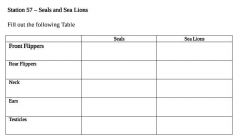
|
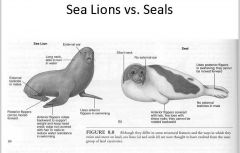
|
|
|
Station 59 – Eared Seals1.How do you tell male from female sea lions? 2. Where are California Sea Lions found? |
1. Males are larger than females, and have thicker neck and protruding crest. 2. California sea lions are native to western North America. |
|
|
Station 60- Earless Seals1. How do they differ from eared seals? How can they help control their body temperatures?2. What are Weddel Seals known for?3. What do Crabeater Seals Eat? How do they do this?4. Where do Leopard Seals hunt? What do they feed on? How are they similar to Crabeater Seals?5. What are harbor seals known for?6. What kind of reproductive strategy do Elephant Seals exhibit? What is sexual dimorphism? How large are the males? How large are the females? |
1. Differ from eared seals: more specialized for aquatic life than otariids./ They control their body temperatures because they are able to deivert blood flow to blubber. 2. Weddel seals are known for deep diving ability, deepest diving seal. 3. Crabeater seals eat: Antarctiv krill of the southern ocean, for which it has uniquely adapted sieve-like tooth structure. 4. Leopard seals hunt in cold waters surrounding Antarctica./ They switch from krill to more substantial prey including penguinsand other seals./ They are similar to crabeater seals: molar lock together that allow them to sieve krill from water. 5. Harbor seals are known for being the most widely distributed of the pinnipeds. 6. Reproductive strategy do elephants seal exhibit: males keep harems called polygyny./ Sexual dimorphism is the differene in size between the two sexes./ Males may grow over 13ft and weigh 4,500 lbs and females are 10ft and weigh 1,500lbs. |

